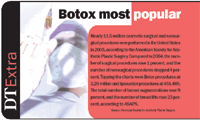- Acne
- Actinic Keratosis
- Aesthetics
- Alopecia
- Atopic Dermatitis
- Buy-and-Bill
- COVID-19
- Case-Based Roundtable
- Chronic Hand Eczema
- Chronic Spontaneous Urticaria
- Drug Watch
- Eczema
- General Dermatology
- Hidradenitis Suppurativa
- Melasma
- NP and PA
- Pediatric Dermatology
- Pigmentary Disorders
- Practice Management
- Precision Medicine and Biologics
- Prurigo Nodularis
- Psoriasis
- Psoriatic Arthritis
- Rare Disease
- Rosacea
- Skin Cancer
- Vitiligo
- Wound Care
Article
New technologies: Filling in the gaps
Poly-L-lactic acid is also being used by some physicians off-labelas a volume restorer for cosmetic enhancement in non-HIV patients.
National report - Soft tissue augmentation with poly-L-lactic acid and fractional resurfacing using the 1,550-nm erbium fiber laser are emerging as useful techniques for cosmetic surgeons and dermatologists, says Elizabeth F. Rostan, M.D., who is a dermatologist and cosmetic surgeon in private practice in Charlotte, N.C.

"This agent is used not for correcting lines and wrinkles, but for improving the appearance of deeper defects, such as for hollows in the cheeks, temples and under the eyes. As it is still relatively new, further experience is needed to determine optimum methods for reconstitution and injection and to characterize the longevity of its benefits. However, poly-L-lactic acid seems to have brought a new tool for achieving longer-lasting volume augmentation," Dr. Rostan says.
Patients typically receive a series of two to four injections that are administered at intervals of two to four weeks. The material is supplied as a lyophilized powder that is reconstituted with 4 cc to 5 cc of sterile water for injection. Many users are also adding 1 cc of lidocaine to the vial, which may contribute to the overall comfort of the injection procedure.
Dr. Rostan injects poly-L-lactic acid using a 25-gauge needle, avoiding overfilling in anticipation of a host tissue response, and then massages the treated site.

Delivery subdermally and not more superficially is important to avoid granulomatous reactions that can lead to the appearance of papules. So far, when attention is given to proper injection technique, poly-L-lactic acid has had a very favorable safety and efficacy profile.
"My patients have been very happy with the amount of volume restoration they are achieving with this material, but it will be important to gather data during continued follow-up in order to evaluate their satisfaction over the long-term," Dr. Rostan says.
Safe, significant resurfacing possible
Fractional resurfacing is a versatile technique that can be used to treat photo-damaged skin on the face, neck, chest and forearms as well as for melasma and atrophic acne scars. It is rapidly gaining popularity because it can provide significant rejuvenation without significant downtime, Dr. Rostan says.
"This treatment can be used to achieve improvements in the textural and pigmentary changes of photoaging that exceed the results of non-ablative laser or intense pulsed light procedures.," Dr. Rostan notes.
In fractional resurfacing, the laser energy is delivered in microscopic spots using a computer-generated pattern to produce columns of photocoagulated tissue. The thermal injury penetrates deep into the dermis to induce connective tissue remodeling. However, only about 15 percent to 20 percent of the total skin area is affected.
"With up to 80 percent of the skin spared, there is little to no down time and enhanced post-treatment healing," Dr. Rostan says.
Newsletter
Like what you’re reading? Subscribe to Dermatology Times for weekly updates on therapies, innovations, and real-world practice tips.














